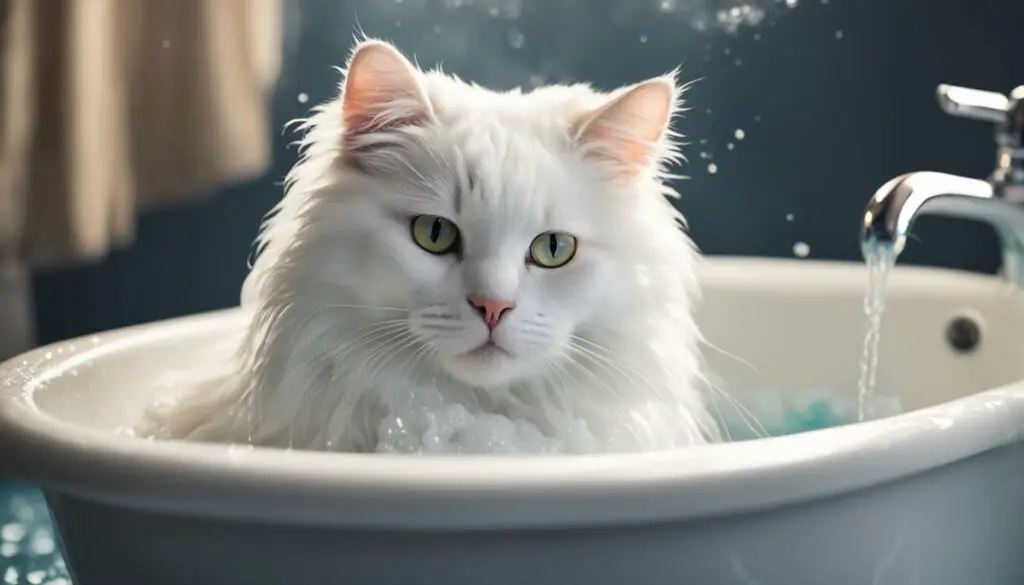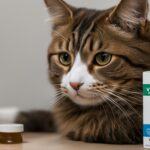Removing fleas from your feline companion is a top priority for pet owners. While bathing can be an effective method to kill fleas on your cat, it’s important to understand the proper techniques and potential risks involved.
In this article, I will provide expert tips on whether you can give your cat a flea bath two days in a row, explore the limitations of bathing in flea control, and discuss alternative methods for effective flea prevention.
Key Takeaways:
- Bathing your cat daily may not be necessary and can have potential risks.
- Consider the limitations of bathing in controlling fleas and focus on addressing the entire infestation.
- Consult a veterinarian for expert advice on the best flea treatments and prevention methods.
- Regular grooming, including the use of a flea comb, is essential for keeping your cat flea-free.
- Maintain a clean environment and follow a comprehensive flea control routine for optimal results.
The Importance of Bathing a Flea-Infested Cat
When it comes to flea control for cats, bathing plays a crucial role in eliminating fleas from their bodies. However, it’s important to be aware of the potential risks and complications associated with bathing a flea-infested cat. One common method of flea control is using flea shampoo, which often contains insecticides to kill the fleas. While these insecticides can effectively eliminate fleas, they can also be harmful to your pet.
When a cat grooms itself after being bathed with flea shampoo, it may ingest the insecticides present on its fur. This can lead to various grooming issues and even skin problems. The cat’s skin may become irritated or develop an allergic reaction to the harsh chemicals in the shampoo. It’s crucial to consider these potential risks before using flea shampoo on your feline companion.
It’s important to prioritize the well-being of your cat and choose safe alternatives for flea control. Consulting with a veterinarian can provide valuable guidance on the best methods and products to use. They can recommend gentle flea shampoos or other effective treatments that won’t harm your cat’s skin or overall health.
“Bathing a cat with fleas requires caution and knowledge of the potential risks. It’s essential to prioritize the well-being of your feline companion and choose safe alternatives for flea control.”
In conclusion, while bathing a flea-infested cat can help eliminate fleas from its body, it’s important to be mindful of the potential risks associated with flea shampoo and other insecticides. Grooming issues and skin problems can arise if these products are not used carefully. Always consult with a veterinarian to ensure you are using safe and effective flea control methods for your cat’s specific needs.
The Limitations of Bathing in Flea Control
While bathing can help kill fleas on a cat, it alone cannot eliminate a flea-infested environment. Fleas have a complex life cycle that includes eggs, larvae, pupae, and adults. Bathing primarily targets adult fleas on the cat’s body, but it does not address the eggs and larvae that may be present in the environment.
When a cat moves around in a flea-infested environment, it can easily become reinfested with fleas. The eggs and larvae can be present in bedding, rugs, furniture, and other areas where the cat spends time. Without addressing these areas, the flea infestation can persist regardless of how often the cat is bathed.
In order to effectively prevent flea infestations, it is important to take additional measures. This includes regularly cleaning and vacuuming the cat’s environment, washing bedding and rugs in hot water, and using flea control products specifically designed for the environment. By combining these efforts with regular bathing and flea control treatments for the cat, you can greatly reduce the risk of flea infestations and keep your feline companion happy and healthy.

| Limitations of Bathing in Flea Control | Effective Measures for Flea Control |
|---|---|
| Bathing only targets adult fleas on the cat’s body. | Regularly clean and vacuum the cat’s environment. |
| Fleas can lay eggs and larvae in the environment, leading to reinfestation. | Wash bedding and rugs in hot water to kill flea eggs and larvae. |
| Cat’s movement in a flea-infested environment can reintroduce fleas. | Use flea control products specifically designed for the environment. |
Addressing Fleas on Your Cat and in Its Environment
When it comes to flea control, addressing both your cat and its environment is essential for effective results. Incorporating a comprehensive approach that includes a regular grooming routine, using a flea comb, seeking veterinary advice, and maintaining a proper home cleaning routine can help in the battle against fleas.
Grooming your cat is an important step in addressing fleas. Regular brushing not only helps remove any existing adult fleas but also allows you to check for any signs of flea infestation, such as flea dirt or eggs. Incorporating a flea comb into your cat’s grooming routine can help in the physical removal of fleas from their fur.
For those looking for a natural remedy, a dawn soap remedy can be effective in killing fleas on contact. Mixing a small amount of gentle, unscented dish soap with warm water creates a safe solution that can be used for bathing your cat. However, it’s always recommended to consult with your veterinarian before trying any alternative solutions.
To fully address the flea problem, it’s important to seek veterinary advice. Your veterinarian can provide expert guidance on flea medicines that are safe and effective for your cat. They can also educate you on the flea life cycle, helping you better understand the importance of consistent prevention measures.
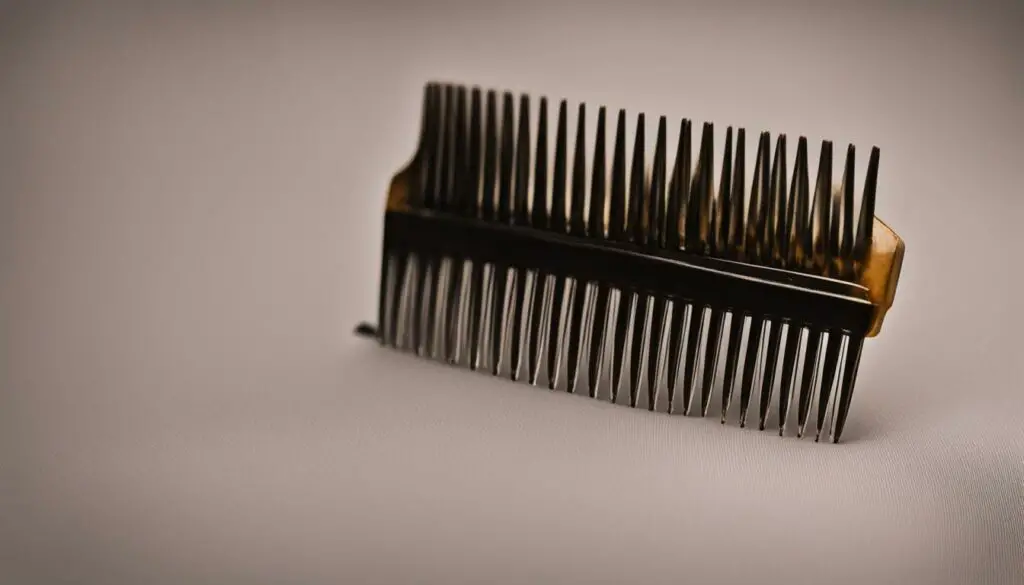
Table: Comparative Overview of Flea Control Methods
| Flea Control Method | Advantages | Disadvantages |
|---|---|---|
| Flea Medicines (Topical or Oral) |
|
|
| Flea Collars |
|
|
| Home Cleaning Routine |
|
|
The Role of Medications in Flea Control
When it comes to flea control, medications play a crucial role in effectively eliminating and preventing fleas on cats. There are various types of medications available, including topical medicines, oral treatments, and flea collars. These medications are designed to target and eradicate fleas, ensuring the health and well-being of your feline companion.
Topical medicines, such as spot-on treatments, are applied directly to the cat’s skin, typically between the shoulder blades. They work by killing adult fleas and preventing the development of flea eggs and larvae. These medications provide long-lasting protection, usually for one month, and are easy to apply.
Oral medications are another option for flea control. These medications are administered orally, either as tablets or flavored chews, and work by inhibiting the growth and reproduction of fleas. They are effective in killing adult fleas and preventing infestations. Oral medications are convenient and provide systemic protection against fleas.
In addition to topical and oral medications, flea collars can also be used for flea control. These collars release active ingredients that kill fleas and prevent infestations. They provide continuous protection against fleas and are suitable for cats that may have difficulty with topical treatments or oral medications.
| Medication Type | Benefits |
|---|---|
| Topical Medicines (Spot-on treatments) | – Kills adult fleas – Prevents flea egg and larvae development – Long-lasting protection |
| Oral Medications (Tablets or flavored chews) | – Inhibits flea growth and reproduction – Kills adult fleas – Convenient and easy to administer |
| Flea Collars | – Kills fleas and prevents infestations – Continuous protection – Suitable for cats with topical or oral medication challenges |
It’s important to consult with a veterinarian to determine the most suitable medication for your cat’s specific needs. They can provide guidance on the appropriate dosage, application method, and potential side effects. Additionally, it’s essential to follow the instructions and dosage recommendations provided by the manufacturer for each medication.
In some cases, professional pest control may be necessary, especially for severe flea infestations. Pest control experts have access to professional-grade products and techniques that can effectively eliminate fleas from both the cat and its environment. They can provide comprehensive solutions for flea control.
While medications are important for flea control, it’s also crucial to prioritize regular pet grooming and other health measures. Regular grooming, including brushing and using a flea comb, helps remove fleas from the cat’s fur and allows for early detection of infestations. Maintaining a clean and hygienic environment, practicing flea prevention, and ensuring your cat’s overall well-being are all essential aspects of flea control.
The Importance of Simultaneous Cleaning
When it comes to flea control, it’s not just about treating your cat. Simultaneous cleaning of your cat’s environment is crucial for effective flea elimination and prevention. By addressing both the cat and its surroundings, you can ensure a flea-free home and keep your feline companion healthy and happy.
One key aspect of simultaneous cleaning is using flea spray in your home. Flea spray will help kill any remaining fleas or eggs in carpets, furniture, and other areas where fleas might be hiding. Be sure to follow the instructions on the flea spray carefully to ensure the safety of both your cat and yourself.
In addition to flea spray, regular vacuuming plays a significant role in the elimination of fleas. Vacuuming not only removes adult fleas, but it also helps to get rid of the eggs and larvae that might be present in your home. Remember to vacuum all areas where your cat spends time, including upholstery, rugs, and bedding.
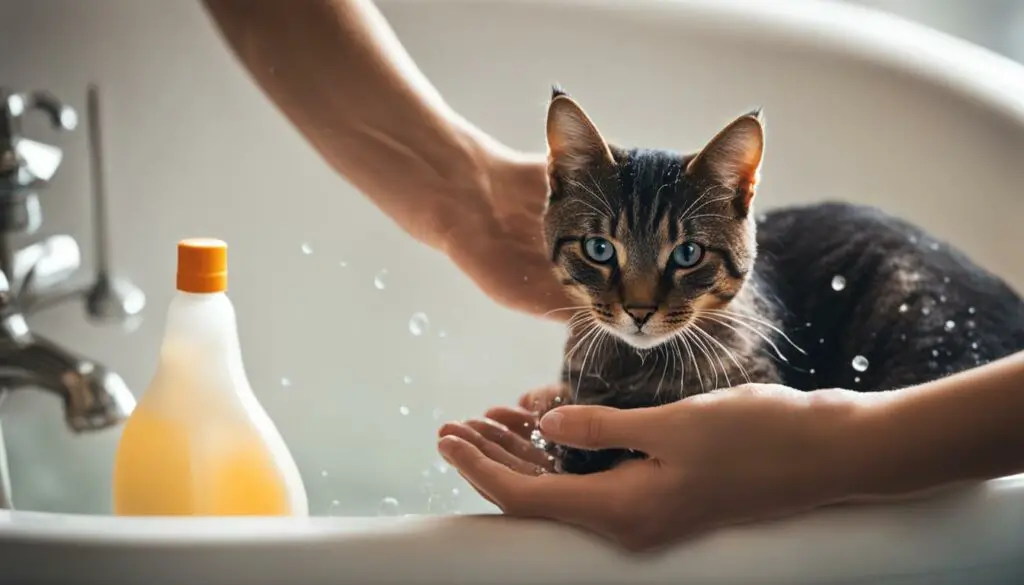
The Benefits of Simultaneous Cleaning
Simultaneous cleaning not only eliminates fleas but also creates a clean and healthy environment for your cat. In addition to flea prevention, maintaining proper pet hygiene is essential for your cat’s overall well-being. Regular cleaning and grooming, combined with simultaneous cleaning, will help keep your cat’s coat in optimal condition and reduce the risk of flea infestations.
If you have outdoor cats or multiple pets in your household, it becomes even more important to practice simultaneous cleaning. Outdoor cats are more likely to come into contact with fleas and bring them indoors. Treating all pets in your home and regularly cleaning the environment will help prevent the spread of fleas and protect the health of all your furry friends.
By implementing simultaneous cleaning as part of your flea control routine, you can effectively eliminate fleas, create a healthy living environment, and ensure the well-being of your beloved furry friend.
The Importance of Consistent Efforts
When it comes to flea elimination, consistent efforts are key to success. Understanding the flea life cycle is crucial in developing a comprehensive approach to tackle these pesky pests. Fleas go through four stages: eggs, larvae, pupae, and adults. Each stage requires different treatment methods to fully eradicate them from your cat and its environment.
Vacuuming regularly is one of the most effective ways to eliminate fleas at various life stages. Vacuuming not only removes adult fleas but also helps to get rid of their eggs and larvae, preventing further infestations. Be sure to pay extra attention to areas where your cat spends most of its time, such as bedding, carpets, and upholstery.
In addition to vacuuming, using pet medication is crucial in flea prevention and control. There are various options available, such as spot-on treatments, oral medications, and flea collars. Consult with your veterinarian to determine the most suitable medication for your cat. It’s important to follow the recommended dosage and application instructions to ensure its effectiveness.
| Treatment Method | Advantages | Disadvantages |
|---|---|---|
| Flea shampoos | Kills existing fleas on the cat | May contain insecticides that can be harmful to pets |
| Spot-on treatments | Provides long-lasting protection | May cause skin irritation in some cats |
| Oral medications | Easy to administer | May not be suitable for cats with certain health conditions |
| Flea collars | Continuous protection against fleas | Some cats may be sensitive to the collar materials |
Table: Comparison of Different Treatment Methods
To supplement your efforts, consider professional pest control services, especially in severe infestations. Pest control experts have the knowledge and tools to effectively eliminate fleas from your cat’s environment. They can also provide recommendations on maintaining a clean and flea-free home.
By consistently vacuuming, using appropriate pet medication, and seeking professional help when needed, you can ensure the long-term success of your flea control efforts. Remember, prevention is always better than cure, so maintaining a clean environment and practicing good pet hygiene are key to keeping fleas at bay.
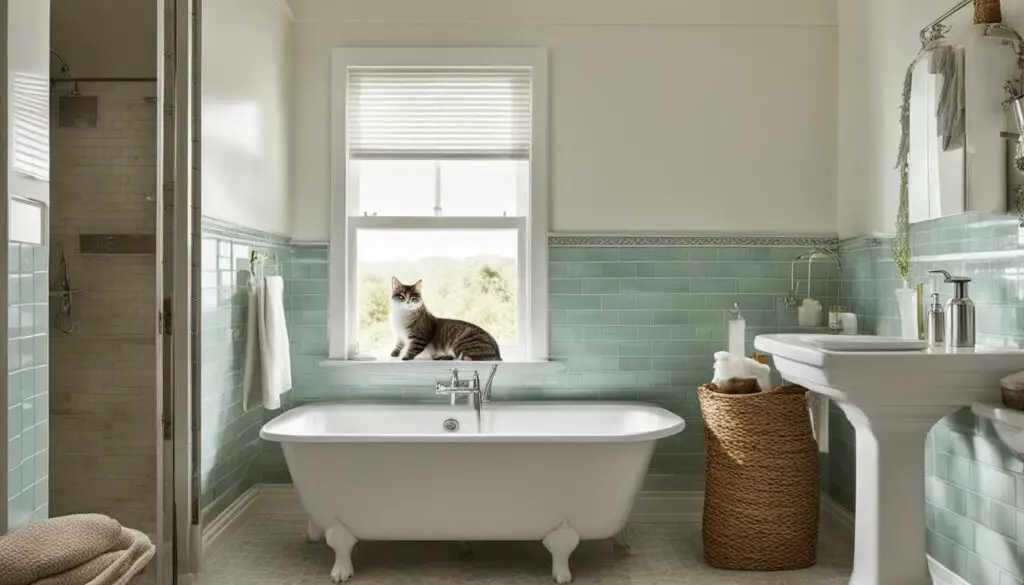
Understanding the Frequency of Cat Baths
When it comes to flea control, the frequency of cat baths plays a crucial role in maintaining your feline companion’s hygiene and keeping pesky fleas at bay. The ideal frequency of bathing depends on various factors such as the cat’s individual circumstances, the severity of the flea infestation, and the advice of your veterinarian. Generally, it is recommended to bathe cats with fleas on a monthly basis to effectively control the infestation.
Bathing kittens with fleas requires extra caution as their delicate skin may be more sensitive to the chemicals found in flea shampoos. It is best to consult with your veterinarian for guidance on the appropriate bathing frequency and suitable products for kittens. Their expertise will ensure that the bathing process is safe and effective for your furry little ones.
Veterinary advice is essential when it comes to determining the frequency of cat baths for flea control. Every cat is unique, and their environmental conditions and infestation levels may vary. By consulting with your veterinarian, you can tailor a grooming routine that aligns with your cat’s specific needs, ensuring optimal flea control.
Bathing Kittens
Bathing kittens with fleas requires special attention due to their delicate nature. It is important to follow the guidance of your veterinarian, who can provide specific instructions on the frequency and methods for bathing kittens. Additionally, they can recommend safe and gentle products suitable for their sensitive skin. By ensuring proper care and consideration, you can protect your kittens from fleas while maintaining their overall health and well-being.

| Grooming Frequency | Benefits |
|---|---|
| Monthly | Effectively control flea infestation |
| As recommended by veterinarian | Tailored to individual cat’s needs |
| Consult veterinarian for kittens | Safe and gentle bathing for delicate skin |
The Benefits of Bathtime for Cats
I understand that many cat owners may feel hesitant or even anxious about giving their feline companions a bath. However, regular bathtime can actually provide a range of benefits for both your cat’s hygiene and overall well-being. Let’s explore the advantages of incorporating bathtime into your grooming routine and how it can contribute to effective flea control.
First and foremost, bathtime allows for the thorough removal of fleas from your cat’s fur. While other flea control methods may target the adult fleas, bathing can physically eliminate these pesky parasites, helping to provide relief for your cat. By using a mild cat-specific shampoo and gently massaging it into their coat, you can effectively remove fleas and promote a flea-free environment.
Beyond flea removal, bathtime also promotes good cat hygiene. It helps to keep your cat’s fur clean and odor-free, preventing matting and discomfort. Regular bathing can also contribute to the health of their skin and coat, leaving them with lustrous fur and reducing the risk of skin issues. Additionally, the bonding experience during bathtime can strengthen the relationship between you and your cat, fostering trust and creating a positive association with grooming.
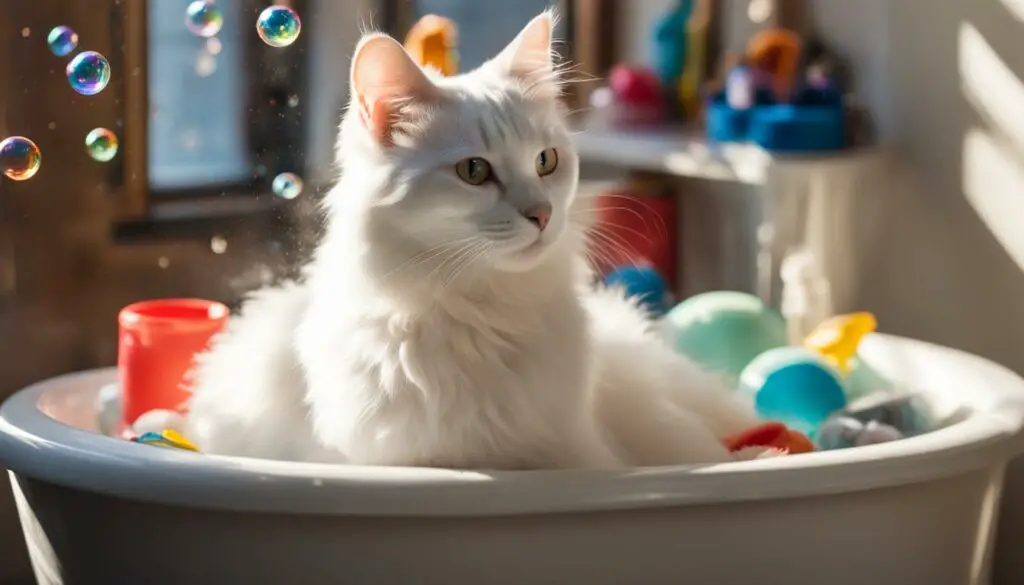
The Importance of Gentle Handling
It is important to approach bathtime with gentleness and patience. Cats are known to be sensitive to water and may initially resist or become stressed during the process. By creating a calm and soothing environment, using warm water, and speaking to your cat in a reassuring tone, you can help alleviate their anxiety. Gradually introducing your cat to bathtime at a young age can also help them become accustomed to the experience.
Incorporating Bathtime into Flea Control
While bathtime alone may not fully eliminate fleas from your cat’s environment, it can be an effective component of your overall flea control routine. By combining regular bathing with other flea control methods such as topical treatments, flea collars, and environmental cleaning, you can create a comprehensive approach to flea prevention and elimination. Consult with your veterinarian for personalized advice on the most suitable flea control methods for your cat.
Alternative Methods for Flea Control
When it comes to flea control, there are alternative methods that pet owners can consider in addition to traditional treatments. These natural remedies can provide an alternative approach to flea prevention and help create a flea-free home environment. One such method is the use of essential oils, such as peppermint oil, which can act as a natural flea repellent.
Essential oils can be applied topically on the cat’s fur or used in diluted form as a spray in the cat’s living areas. However, it’s important to use essential oils safely and in consultation with a veterinarian. Some essential oils can be toxic to cats, so it’s crucial to ensure the chosen oil is safe for feline use.
Alongside alternative methods, maintaining a clean and hygienic home environment is essential for effective flea control. Regular vacuuming of carpets, furniture, and bedding can help remove flea eggs and larvae. Additionally, washing pet bedding and blankets in hot water can help kill fleas and prevent their return. A clean and well-maintained home can significantly reduce the risk of flea infestations.
Benefits of Alternative Methods for Flea Control
There are several benefits of using alternative methods for flea control. Firstly, these natural remedies offer a chemical-free approach, reducing the exposure of both cats and humans to potentially harmful substances. Additionally, alternative methods are often cost-effective and readily available, allowing pet owners to take proactive measures without breaking the bank.
Alternative methods for flea control provide a natural and holistic approach to flea prevention and maintenance of a flea-free home environment.
However, it’s important to note that while alternative methods can be effective, they may not provide the same level of efficacy as traditional treatments. It’s essential to closely monitor the cat’s flea infestation and consult with a veterinarian for the best course of action. Veterinarians can provide expert guidance and recommend suitable alternative methods for individual cats based on their health and specific needs.
| Pros of Alternative Methods | Cons of Alternative Methods |
|---|---|
| Chemical-free approach | Varied efficacy |
| Cost-effective | Requires close monitoring |
| Readily available | May not be suitable for all cats |
Conclusion
Alternative methods for flea control can provide pet owners with additional options for maintaining a flea-free home environment. Natural remedies, such as essential oils, offer a chemical-free approach, while regular cleaning and hygiene practices can further contribute to effective flea prevention. However, it’s important to remember that alternative methods may not offer the same level of efficacy as traditional treatments, and close monitoring of the cat’s flea infestation is crucial. By combining traditional and alternative methods, pet owners can tailor their flea control approach to best suit their cat’s needs and overall well-being.
The Importance of Seeking Veterinary Help for Flea Infestations in Cats
When it comes to flea infestations in cats, seeking veterinary help is crucial for the health and well-being of your feline companion. Veterinarians are the experts in flea control and can provide valuable guidance and assistance in dealing with these pesky parasites. If you notice signs of a flea infestation or your cat is experiencing flea-related complications, don’t hesitate to reach out to a flea control expert.
A veterinarian will be able to accurately diagnose the extent of the flea infestation and assess the overall health of your cat. They have the knowledge and resources to recommend appropriate flea control measures and prescribe the necessary medications to effectively eliminate fleas. A professional evaluation is especially important in severe cases where home remedies or over-the-counter products may not be sufficient.
Flea-related complications can vary from mild skin irritation to more serious issues such as anemia or the transmission of other diseases. By seeking veterinary help promptly, you can address these complications early on and prevent any further health issues. Additionally, a veterinarian can offer advice on preventative measures to help protect your cat from future flea infestations.
Why Choose a Veterinary Expert for Flea Control
While there are several flea control products available in stores, a veterinarian can help you determine the most appropriate treatment plan for your cat’s specific needs. They can recommend safe and effective flea control methods based on your cat’s health, age, and lifestyle. Additionally, they may provide valuable insights on environmental management strategies to prevent re-infestations.
Remember, your cat’s health and well-being should always be the top priority. Don’t hesitate to consult with a veterinary professional if you suspect a flea infestation or are experiencing difficulties in controlling fleas. They have the expertise to guide you through the process and ensure that your cat receives the best possible care.
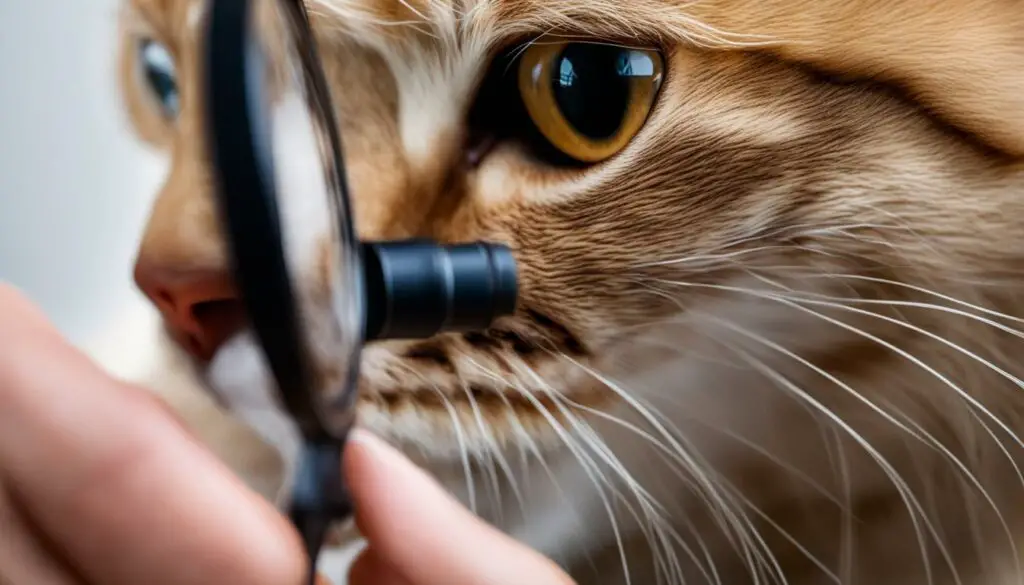
| Benefits of Seeking Veterinary Help for Flea Infestations in Cats |
|---|
| Accurate diagnosis of flea infestation |
| Assessment of overall cat health |
| Recommendation of appropriate flea control measures |
| Prescription of necessary medications |
| Early detection and treatment of flea-related complications |
| Advice on preventative measures for future infestations |
Maintaining a Grooming Routine for a Healthy Cat
Grooming plays a crucial role in keeping our cats healthy and happy. Regular brushing and proper coat maintenance not only keep their fur looking its best but also contribute to overall well-being. By establishing a consistent grooming routine, we can prevent flea infestations, improve pet hygiene, and ensure the well-being of our feline companions.
Regular brushing is an essential aspect of a grooming routine. It helps remove loose hair, prevents matting, and encourages good blood circulation in the cat’s skin. It is also an opportunity to check for any signs of fleas or skin issues. By using a flea comb during brushing, we can quickly detect and remove any unwanted visitors, ensuring effective flea prevention.
In addition to brushing, maintaining a clean and healthy coat can be achieved through other grooming practices. Regularly trimming the cat’s nails prevents them from becoming too long and causing discomfort. Keeping the ears clean and free from debris is also important. It’s essential to consult a veterinarian for guidance on the proper techniques and products for these tasks.
Benefits of Regular Grooming:
- Promotes a healthy coat and skin
- Prevents matting and tangles
- Stimulates blood circulation
- Helps detect and prevent fleas
- Strengthens the bond between cat and owner
Remember, maintaining a grooming routine involves more than just brushing. It’s important to provide a clean environment for the cat, including regular bedding changes and keeping their living area free from dirt and pests. A well-rounded approach to grooming, combined with proper nutrition and regular veterinary care, contributes to the overall health and happiness of our beloved feline companions.
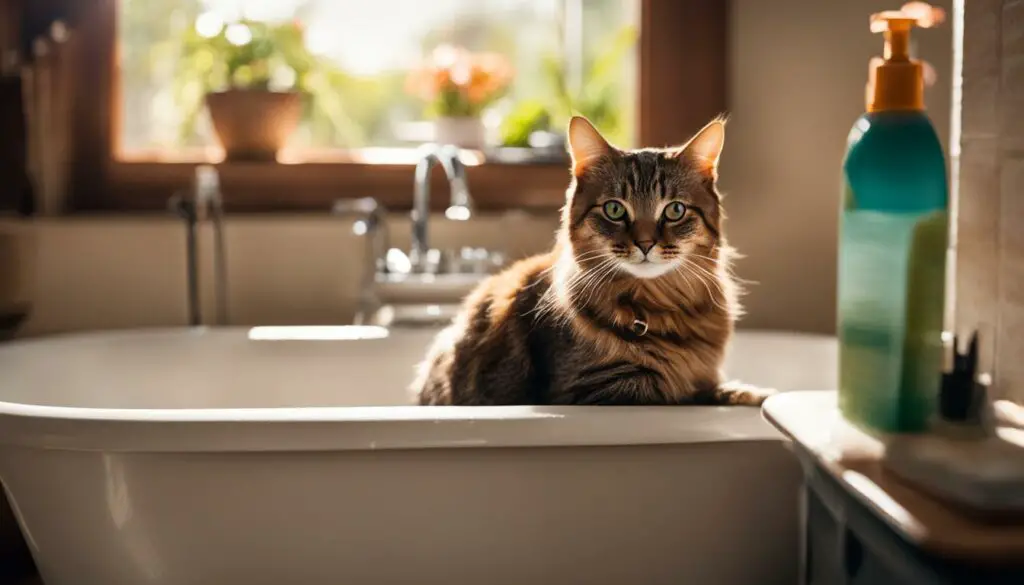
The Importance of Prioritizing Flea Control for Your Cat’s Health
As a pet owner, ensuring the health and well-being of your feline companion is of utmost importance. One common concern among cat owners is how to effectively control and prevent flea infestations. By implementing a comprehensive flea control regimen that includes a regular grooming routine, you can keep your cat healthy and free from these pesky parasites.
A grooming routine is essential for maintaining your cat’s health and preventing fleas. Regular brushing not only helps remove dirt and debris from your cat’s fur, but it also allows you to check for any signs of fleas or flea dirt. Using a flea comb can be particularly effective in capturing and removing any adult fleas or eggs that may be present.
In addition to a grooming routine, it’s important to address flea control in your cat’s environment. Keeping your home clean and free from fleas is crucial in preventing reinfestation. Regularly vacuuming carpets, furniture, and bedding can help remove any flea eggs or larvae that may be hiding in these areas. Utilizing appropriate flea control measures, such as flea medicines or flea collars recommended by your veterinarian, can also provide additional protection for your cat.
By prioritizing flea control and maintaining a consistent grooming routine, you can ensure the health and happiness of your beloved feline friend. Remember, prevention is key when it comes to fleas, so it’s essential to stay proactive in your efforts to keep your cat free from infestation. By doing so, you can create a safe and comfortable environment for both you and your cat.
FAQ
Can I give my cat a flea bath 2 days in a row?
It is generally not recommended to bathe your cat with flea shampoo multiple days in a row. Flea shampoo often contains insecticides that can be harmful to your pet’s skin and overall health. It’s important to follow veterinary advice regarding flea treatments.
What are the risks associated with using flea shampoo?
Flea shampoo may contain insecticides that can enter your pet’s system when it grooms itself. This can potentially cause skin issues and other health problems. It’s important to consider the potential risks before using flea shampoo and consult with a veterinarian.
Can bathing alone eliminate a flea-infested environment?
No, bathing alone cannot eliminate a flea-infested environment. Fleas can lay eggs in furniture and rugs, making it necessary to address the entire infestation. Additionally, fleas can reinfest your cat after bathing, as they may be present in the environment. Additional measures are needed to prevent flea infestations.
How can I effectively address fleas on my cat and in its environment?
To effectively address fleas, you should target both your cat and its environment. Regular grooming, including the use of a flea comb, can help remove fleas from your cat’s fur. Consulting a veterinarian can provide expert advice on available treatments and prevention methods. Understanding the life cycle of fleas is also important for comprehensive flea control.
What role do medications play in flea control?
Medications play a crucial role in flea control. Topical medicines, oral treatments, and flea collars are common options to eliminate and prevent fleas on your cat. In severe infestations, professional pest control may be necessary. Regular pet grooming and other health measures can also help prevent fleas.
How can I simultaneously clean my cat’s environment to eliminate fleas?
Simultaneous cleaning of your cat’s environment is crucial for effective flea elimination. Washing bedding, vacuuming carpets and upholstery, and using flea sprays can help remove fleas and prevent their return. It’s important to prevent outdoor cats from bringing fleas indoors and to treat all pets in the household. Regular cleaning is essential for flea prevention.
How often should I bathe my cat for flea control?
The frequency of cat baths for flea control depends on your cat’s individual circumstances. It is generally recommended to bathe cats with fleas once a month, but the frequency may vary based on your cat’s environment and infestation level. It’s important to follow veterinary advice for the best flea control regimen.
What are the benefits of bathtime for cats?
Regular bathtime can have various benefits for cats. Bathing helps remove fleas, maintain your cat’s hygiene, and promote overall fur health. It also contributes to a flea-free environment when combined with other flea control measures. With a positive and gentle approach, many cats can come to enjoy bathtime.
Are there alternative methods for flea control?
Some pet owners opt for natural remedies for flea control, such as using essential oils like peppermint oil. However, it’s important to use them safely and consult with a veterinarian. Maintaining a clean and flea-free home is essential for effective flea control.
When should I seek veterinary help for flea control?
In severe cases of flea infestation or if your cat experiences flea-related complications, it’s important to seek veterinary help. Veterinarians can provide expert advice, prescribe appropriate medications, and offer guidance for flea control. They are the best resource for addressing complex flea issues and ensuring your cat’s health and well-being.
How can I maintain a grooming routine for a healthy cat?
Regular grooming is crucial for maintaining a healthy cat and preventing fleas. This includes brushing your cat’s fur, using a flea comb, and checking for fleas. Additionally, maintaining a clean environment, providing proper nutrition, and keeping up with veterinary care contribute to overall cat health.
Source Links
- https://www.elysiuminstruments.com/blog/pet-grooming/how-often-should-i-bathe-my-cat-with-fleas/
- https://be.chewy.com/help-my-cat-has-fleas-signs-treatment-and-prevention/
- https://www.wikihow.com/Kill-Fleas-With-Dawn-Dishsoap

